Can You Put a Mini Fridge on Carpet? Not Without...
Author: Rick Worst | Editor: Omar Alonso
Review & Research: Jen Worst & Chris Miller

Do you feel like a tasty cold soda as you chill on the couch and watch Netflix? You feel so relaxed and comfortable that maybe it's not worth getting off the couch to grab the drink. Buying a mini fridge and installing it next to the sofa solves the problem. But can you put a mini fridge on carpet?
Most people have a carpeted living room, and there might be an issue with standing a mini fridge on a carpeted surface. This post unpacks if it's possible to place your mini fridge on a carpeted surface.
Can You Put a Mini Fridge on Carpet? 4 Ways to Make it Work
Sure, you can place the mini fridge on the carpet, but it's not ideal. Surprisingly, leaving the mini fridge on this surface affects its performance and reduces its service life. The carpet causes heat buildup and blocks the airflow under the unit.
So, for effective operation, you'll need to leave a gap between the bottom of the mini fridge and the floor. The best idea is to place the fridge on tiled, linoleum, or hardwood flooring. If you don't have space in your apartment for the mini fridge or you're moving into a dorm, you might not have the right surface available.
You can follow our hacks to get better performance and longer service life out of your mini fridge, even on a carpeted surface. You have to treat them like real-deal types of refrigerators, because they are. Don't mistreat them because they're smaller.
1) Place a Protective Layer Under the Mini Fridge
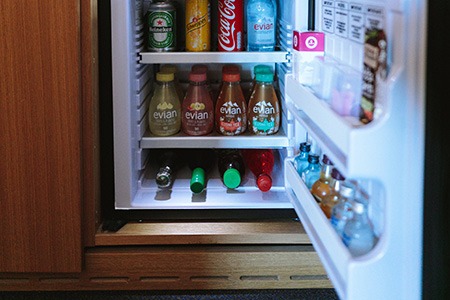
Placing a mini fridge on a carpet cuts its service life in half and reduces the cooling function of the appliance. So, you need to get more room under it to allow for adequate airflow to the coils. Placing a buffer between the carpet and the fridge is the easiest solution to solve the problem. So, what to put under a refrigerator on carpet, then?
Get a piece of sturdy plastic and place it under the leveling feet. You could use a solid plastic sheet, a rubber mat, or even a bit of plywood. However, wood isn't as effective as plastic or rubber because it absorbs moisture and may rot if not sealed. It won't look nice indoors either. Opt for a plastic pan with raised lips.
2) Look for a Mini Fridge with Coils on the Rear Panel
A typical mini fridge design involves the coils placed on the fridge's underside instead of on the rear of larger models. The coils heat up and require air to move across them to cool them down. The carpet blocks the airflow, resulting in overheating of the coils and impaired functioning of the mini fridge.
Not only will you damage the fridge, but you'll also burn or damage the carpet. Moreover, you also create fire risk for the room and the building.
If you're buying a new model, research and look for a mini fridge with the coils positioned on the appliance's rear. This design won't cause any issues with its performance or service life.
3) Assess the Mini Fridge for Leaks
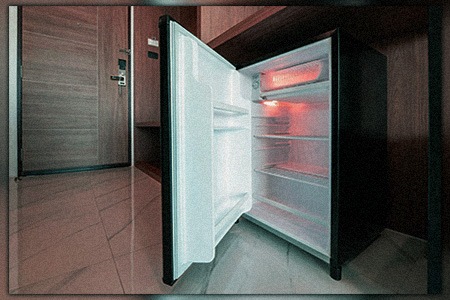
There's still a possibility of carpet damage even when placing a buffer like a rubber mat under the mini fridge. Leaks from the appliance stain and damage the carpet. Before bringing the fridge into the room, plug it in on a tiled or solid surface, run it for 24 hours and check around it for leaks the following day.
4) Check the Mini Fridge Regularly
Since you're running the fridge on a carpeted surface, you'll need to inspect it regularly for leaks. General maintenance every month involves inspecting for leaks and checking the carpeted surface underneath the buffer.
If the fridge looks, the water will seep into the carpet and create the ideal conditions for mold growth. Mold accumulation releases spores into the room, presenting allergy responses and respiratory problems for the residents.
So can a mini fridge sit on carpet? Sure, with a boundary material between it and the carpet you'll have no problems with the carpet suffering damage from water or rusted fridge feet, etc.
What Do I Do If the Mini Fridge Leaks?
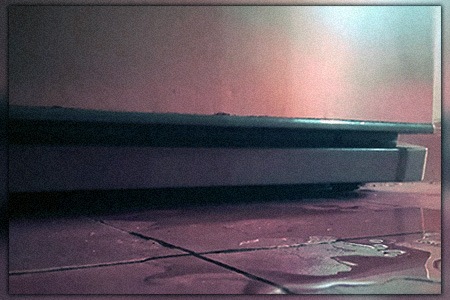
Can you put a mini fridge on carpet? Sure, but all fridges will leak condensation at least from time to time. If the mini fridge starts leaking, you have several options for resolving the problem. You'll need to deal with the fridge first and then make a plan to repair or replace the carpet.
Remove the Mini Fridge from the Carpet
If you notice a leak, unplug it, and pull the fridge out of the room. Open the refrigerator and transfer all items out into a larger fridge. If you don't have a larger fridge, say you're in a college dorm room, transfer it to the community fridge or a cooler.
Wipe down the inside of the fridge to remove excess water, and place the refrigerator on top of some towels to absorb all leaking water until it runs dry. Unplugging the fridge defrosts the appliance, and there'll be considerable water release.
Dry the Carpet if it's Wet
Remove the buffer from the carpet and dry it off. Inspect it for water damage and dry it out. As mentioned, you'll need to dry it entirely to prevent mold growth. In warm climates, mold can begin growing in as little as 48 hours. We recommend using a hair dryer to fast-track the drying time.
The longer you let the water sit on the carpet, the more prone it is to damage the carpet, the underfelt, and the subflooring. Another effective option is renting a wet vacuum to remove the moisture.
Turn on a fan to allow air into the room to speed up the drying process. Finish by adding baking soda to the affected area. The baking soda deodorizes the carpet of any unpleasant smells. It can even be used to deodorize the fridge to keep it from smelling bad even after cleaning it. The last thing you want is the feet to get wet, rusted, and then have you dealing with how to get rust out of carpet.
Where Should You Avoid Placing a Mini Fridge?
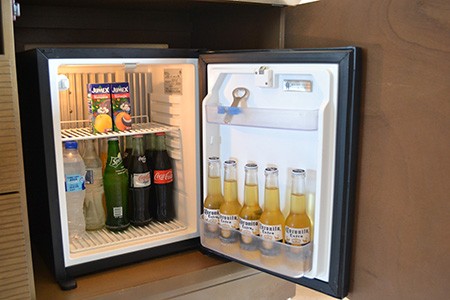
While we've discussed why placing the mini fridge on a carpet is a bad idea, there are other areas in the home where you should avoid placing the unit.
Don't Place it on its Side
The fridge is designed to work in an upright position. Placing it on its side is a bad idea and causes malfunctions. Laying the refrigerator on its side causes compressor oil to leak into the cooling pipes. If you're moving the fridge on its side, let it stand upright for 24 hours before plugging it in. This strategy helps the gases settle, preventing damage to the compressor.
Don't Block the Ventilation
Refrain from blocking the ventilation source cooling the fridge. It reduces appliance performance and service life. Blocking the ventilation causes overheating of the coils and inefficient compressor operation, resulting in costly repairs to the appliance.
Don't Place it Near Heat Sources
Place the mini fridge away from a radiator or heater. The excess heat may damage the coils and compressor. Don't place the fridge next to a stove or other heat sources that interfere with the appliance's ventilation and the cooling action of the coils.
Prevent Overcrowding
Don't overcrowd the interior of the fridge. The mini fridge requires air to circulate inside the cooling box to cool it down. Can you put a refrigerator on carpet? Sure, but that doesn't mean cramming it in a bookshelf or between sofas.
When you overcrowd the refrigerator, you reduce the space for air to flow efficiently, reducing the appliance's cooling ability. The unit must work harder to keep the fridge temperature cooler, reducing service life.
Fridge Temperature
Don't leave the fridge running at maximum cooling temperature. If you do, it will result in more stress on the coils and condenser, reducing service life. Don't run the mini fridge on too low a setting, or you run the risk of defrosting and causing a leak.
Clean Refrigerator Condenser Coils
Most mini fridges have well-protected coils on the underside or the back of the appliance. However, despite them being tucked away, dust enters the unit's interior over time through the ventilation slats.
You'll need to clean off the coils if you're buying a second-hand unit, especially if it's old. This simple task can dramatically improve the cooling performance of the appliance.
FAQ’s Regarding Mini Fridge Operation & Carpet
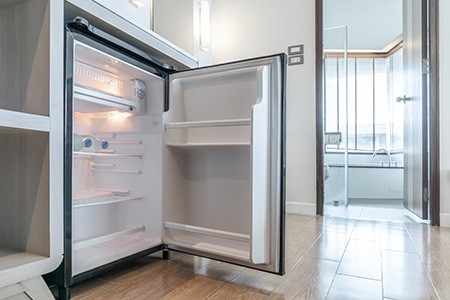
When the topic of mini fridges come up, particularly "can mini fridges sit on carpet?", there’s always a similar set of questions that arise, so we’ll go ahead and deal with those for you now in case you’re wondering the same.
Should I Place the Mini Fridge by a Window?
Don't install the mini fridge next to a sun-facing window. The sun beating down on the top of the appliance causes heating of the casing and the need for the coils and condenser to work harder to keep it cool. As a result, you get a significant reduction in service life and performance.
Why Does My Mini Fridge Run All the Time & Never Shut Down?
Typically, mini fridges run the compressor to cool down the interior around 30% to 50% of the time. If the fridge is continually running, there's a problem with the coils or compressor. Take the refrigerator to an approved service center for servicing and repairs.
How Long Should it Take for My Mini Fridge to Get Cold ?
Typically, it takes a mini fridge around four hours to get cold after plugging it in. There are factors that affect how long it takes for a refrigerator to get cold you can learn about here. The FDA recommends the optimal temperature for a mini fridge at 40 °F for food safety.
Ensure you wait for the fridge to reach this temperature before placing food inside. Putting the food inside before it gets cold results in a long cooling time for the refrigerator to reach optimal temperature.
Can I Switch Off My Mini Fridge at Night?
Studies show turning off the fridge during low-voltage hours at night increases the unit's service life by up to 50%. You should consider what type of food or beverages you have inside and if they are able to be stored at higher temperatures above your normal mini fridge operating temperature.
So Can You Put a Mini Fridge on Carpet? Not Without a Barrier
Can you put a mini fridge on carpet? It's not isn't ideal, but you can do it if you place a buffer material under the unit. If you choose to use this strategy, inspect the unit monthly to ensure there aren't any leaks causing water damage to the buffer material or the carpet.



